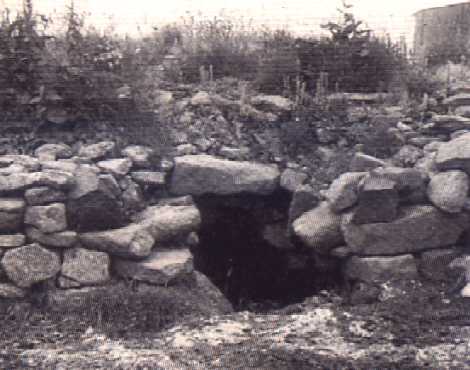|
|
|
No one knows quite why fogous were built. Some guess they were used for cold storage of food while others think they were a hidey-hole. The hidey-hole theory is less likely because with most of them once you were inside there was no other way out. It is more logical to assume that they had a religious purpose of which we know nothing. Possibly the same sort of thing as the native Americans did to contact their ancestors. The radiation levels have been measured inside the fogou and are 87per cent higher than on the outside. This could explain the fact that people go into a trance-like state when inside for long periods of time.
A fogou is the Cornish word for an underground, stone-lined passageway, they are known as souterrains in Ireland, Scotland and Brittany.
![]()
Pendeen Vau
The fogou at Pendeen Vau has its entrance in a hedge, in this case a hedge being a huge ancient wall. It descends steeply and after a while the passageway turns left and all that you can see is a dim light at the far end of the tunnel.

Where the tunnel turns there is a quartz stone embedded in the wall which shines out distinctly. There are several legends associated with this fogou, one of which says that the passageway extended as far as the Scilly Isles or even Lyonesse. Apart from supposedly hiding a treasure the Vau also has a ghost; a beautiful woman dressed in white who appears at the entrance on the winter solstice (Christmas) with a red rose in her mouth. If anyone follows her in to the fogou then she turns into an horrific entity. |
|
![]()
Boleigh Fogou
|
Near Penzance, this fogou is set into the ramparts of an Iron Age enclosure and has a passageway that is 40ft long and 6ft high. A stone on the left as you enter has an indistinct carving that shows a male figure, with long hair, holding a spear in one hand and a serpent in the other. It is likely that this symbolises a Celtic deity and means that the building was a temple for the use of the occupants of the fort. Iron Age pottery has been discovered inside and a shelf cut from the rock at the far end of the tunnel might have served as an altar. |
![]()
Halligye Fogou
Near Helston, this is probably the finest example in England. With a torch you can explore the full length of the tunnels which were under a small fortified homestead dating again from about 1000BC. One passage is 54ft long and the other branches off to form a T shape. Across the floor of the main passage is a block of stone which may have been a stumble stone, giving anyone in the tunnel early warning of intruders. |
|